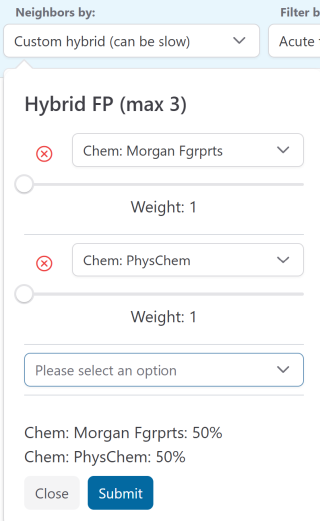GenRA Manual: Other Fingerprint Types
PFAS Fingerprints

Per- and polyfluoroalkyl substances (PFAS) are of particular interest to toxicologists due to their structural diversity and prevalence in modern manufacturing products paired with the negative health effects they have the potential to cause. PFAS presence in the environment continues to increase due to current production use, while past disposal efforts have also resulted in long-term contamination of soil, air, and water. The existing collection of PFAS chemicals is ever-growing, and manufacture of these substances outpaces current efforts to characterize PFAS hazard profiles, implicating the necessity of NAMs for assessing hazard risks. The unique properties of PFAS chemicals, such as grease, oil, heat, and water-resistance, mean that the best source analogues in read-across for PFAS are likely to be related PFAS.
To this end, Richard et. al developed a new CSRML structure-based fingerprint for profiling and categorizing PFAS in 2023. These fingerprints consist of 129 total ToxPrints, 56 of which were adapted from the original 729 public ToxPrints, to allow for bonds, such as CF groups or F attachment, likely to be encountered near the fluorinated portion of a PFAS. These ToxPrints are available for source analogue identification with GenRA as a fingerprint option in the “Neighbors By” menu (Figure 1). PFAS fingerprints exist only for PFAS, so to use this functionality, the user must begin with a candidate PFAS. All source analogues identified using this method will also be PFAS. Note PFAS ToxPrints have only been calculated for a limited set of PFAS drawing on the following TSCA 8(a)(7) Rule List of Chemicals.
![Figures 2 and 3: implementation of PFAS filter for {[1,1,2-Trifluoro-2-(heptafluoropropoxy)ethyl]sulfanyl}acetic acid](/system/files/styles/large/private/images/2024-12/figure-2.-implementation-of-pfas-filter-for-112-trifluoro-2-heptafluoropropoxyethylsulfanylacetic-acid.png?itok=axAOF3gc)
![Figures 2 and 3: implementation of PFAS filter for {[1,1,2-Trifluoro-2-(heptafluoropropoxy)ethyl]sulfanyl}acetic acid](/system/files/styles/large/private/images/2024-12/figure-3.-implementation-of-pfas-filter-for-112-trifluoro-2-heptafluoropropoxyethylsulfanylacetic-acid.png?itok=DudvpCq8)
Additionally, users also have the option to limit their possible source analogues to PFAS even when using other fingerprints in the similarity calculation. To do this, the PFAS8a7v3 list should be selected in the Filter by dropdown (Figure 2). This selection will eliminate any source analogues from consideration if they are not also PFAS, as can be seen in the changed neighborhood in Figure 3. PFAS fingerprints and filters can be used with all other GenRA functionality, including Custom Hybrid fingerprints. Selecting the Next button will continue the GenRA workflow as usual.
Pesticide Fingerprints and Filters

The Resistance Action Committees (RAC) aim to manage the development pesticide resistance in environmental pests. These communities, headed by CropLife International, have developed a Mode of Action (MoA) classification system for insecticides, herbicides, and fungicides. By rotating through different MoAs, RAC members hope to protect crop yield by reducing the likelihood of pesticide resistances arising. The MoA scheme can also yield helpful information about the environmental risks posed by pesticides and provide hints to the Adverse Outcome Pathways likely to be activated by environmental pesticide contamination. This makes MoA similarities a particularly useful tool for drawing comparisons between pesticide chemicals, and thus an increasingly valuable point of interest for read-across.
The MoA schema has been implemented in GenRA as an option for determining similarity. Chemicals must be part of the categorized RAC chemicals list in order to use this functionality. These fingerprints can be found in the Neighbors by menu as “Biology: Pesticide RAC” (Figure 4). The list of MoAs is shorter than the chemotypes involved in many of the fingerprints, making this fingerprint very non-unique (users may encounter many chemicals with identical MoA fingerprints). When applying this method, it is recommended to combine the Pesticide RAC with at least one other descriptor, such as “Chem: Morgan Fgrprts”, using the Custom hybrid functionality.
Users can also filter their source analogue identification based on Pesticide classification. In the Filter by menu, selection of the “Pesticides” option will limit potential source analogues to those chemicals contained in the IRAC, FRAC, and HRAC lists. However, it is worth noting that at present this filter does not require shared MoA between the target chemicals and source analogues, so analogues identified using other fingerprints may not share their MoA with the target chemical. Both the filtering and fingerprint pesticide options are compatible with all other GenRA functionality, and selecting the Next button will continue the GenRA workflow as usual.
Physicochemical Fingerprints
One of the contexts of similarity considered when evaluating source analogues is their similarity with respect to physicochemical properties. To that end, a set of fingerprints were created to enable a pairwise similarity on the basis of selected physicochemical properties. The properties that make up this fingerprint are logKow (the log of the octanol-water) partition coefficient, the molecular weight (average mass), the number of hydrogen bond donors (HBD) and the number of hydrogen bond acceptors (HBA). Property values are calculated/estimated using the OPERA models. Normalized pairwise Euclidean similarities are derived from the 4 properties.

These fingerprints are available for source analogue identification within GenRA as a fingerprint option in the “Neighbors By” menu (see Figure 5).

Users can search for source analogues to return hits that are similar with respect to these properties. Pairwise similarities can often be quite high relative to the similarities calculated on the basis of chemical fingerprints, for this reason, users are encouraged to use the physicochemical fingerprint as an input alongside a chemical fingerprint within the custom hybrid fingerprint option (see Figure 6).
Next Chapter: User-Defined Neighborhoods
